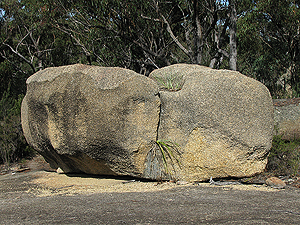(Chemical)
|
|
Falling rain absorbs carbon dioxide from the air, creating a weak carbonic acid. Decaying plant and animal matter creates organic acids which mix with the rainwater, making the resulting groundwater even more acidic. These mild acids react with the feldspar minerals in the granite, turning it into clay.
Likewise, the hydrogen in the water also turns the feldspar to clay, by a process called "hydrolysis". Over time, these chemical reactions can dissolve even the largest of granite boulders into a mixture of kaolinite clay and quartz sand.
Some results of kaolinisation working on the fractured rock mass include:
|
|

Dissolving boulder,
south end of Mt Norman track.
|
|
Next...
Biological Weathering – Plants have their role to play as well.
|

